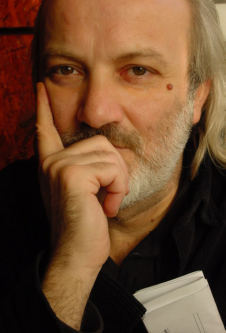
contact
|
full
bio |
web
home
|
DELAXO
DESIGN is an alias for visual work created by Thanos N. Stasinopoulos, an architect
from Athens, Greece.
Being
a freelance designer and also a university tutor, his affection to
photography and computer imagery is not a full-time occupation for the
daily bread, but rather a spontaneous manner of personal expression.
Since
the early '80s, the photographic lens has been his ‘third eye’
focusing on various aspects of reality in order to survey and display
the relationship between ‘look’, ‘see’ and ‘imagine’.
For 15 years photography had been just straightforward 'frame & click' without
altering the image captured by the camera.
Then, in 1995, the preparations for
a photography exhibition triggered a leap from chemical to digital
technology.
The earlier photographs that were transformed into digital creations through computer processing,
were soon coupled by pictures from the Internet and a digital
camera.
The vast new
field of experimental creativity combining photography & image
processing was labeled as "computer
photographics".
The aim
of that creative journey has been the same from the very beginning: To explore and
transform ordinary views into something completely strange, bizarre or
abstract.
It is a kind of de-construction of usual themes and re-construction of an
innovative visual proposal which can
spark imagination and lead to unconventional interpretations of commonly perceived
reality (see some thoughts below).
|
|
|
As a
young boy I used to wonder:
"What
humans would know about the moon or the stars should they have no eyes?" ;
"How
do plants perceive their environment, with whatever kind of senses they might
have?";
"How
many things exist around us that we don't even suspect about because we
do not possess the required senses?"...
Later
I read about Plato's 'cave', with the 'shadows' of cosmic
reality projected on its walls and us struggling to interpret them in our
fervour to solve the puzzle of 'reality'.
Somehow
we have managed to expand our understanding of Cosmos, either by advances
in mental processing of those 'shadows', or due to technology that enriches
our senses -especially vision. So now we know a few more things about e.g.
the infrared world, the plankton or distant galaxies.
Yet,
we still do not 'see' all things around us, for centuries being prisoners of our senses
and the limitations of human thought. But there is no doubt
that we are surrounded and influenced by invisible forces, conditions or
even beings, that perhaps we will comprehend some day, as it has happened
already with magnetic fields or bacteria.
It is
that kind of thinking that I try to depict -or evoke- with my pictures. That's why their usual subject is fragments of the environment, visible
to all, as they appear through the contemporary extension of the eye, the
camera lens, enhanced through adjustments at the near end of the visual
axis.
The simple 'click' of the shutter, which freezes an aspect of reality, encompasses
or acquires elements that exalt conventional vision: Isolation of details
(like in the microscope), transformation of colours (like in infrared photos),
or disclosure of new forms (like in x-rays).
From
the aspect of revealing an 'alternative' look of the world around us, my
pictures are not far from scientific imagery, like e.g. magnetic tomography
or satellite photos. The difference is that my task is not a quantitative
analysis ("The tumour is that big" or "Wheat production in China
is that much"), but a rather poetic depiction of hidden dimensions
of reality.
This
approach differs from the one pronounced by the forms of abstract painting:
They are products of a purely mental conception which is expressed by human-made
pictures following the creator's impulse and skill. The influence of technology,
through the paintbrush or chemistry of colours, is limited.
By contrast,
my pictures are a direct projection of reality itself, like every photograph.
Through subsequent processing, a number of 'filters' are added, based on personal
choice and objectives. The basic instrument -deliberately autonomous sometimes-
is the highlight of contemporary technology, the computer, guided according
to its operating rules.
TNS 1998
|
